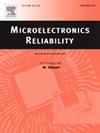Long-term (8000 h) reliability and failures of high-power LEDs for outdoor lighting stressed at high ambient temperatures
IF 1.6
4区 工程技术
Q3 ENGINEERING, ELECTRICAL & ELECTRONIC
引用次数: 0
Abstract
Modern solid-state lighting systems allowed to enhance the energy efficiency of light sources, improve quality and reduce the related costs; however, the reliability of high-power light-emitting diodes (LEDs) is a critical aspect, especially in systems where high powers/small footprints are required.
In this paper, the long-term reliability of high-power light emitting diodes (LEDs) for outdoor lighting is analyzed. LEDs were stressed for 8000 h near their absolute maximum current, at different ambient temperatures (45 °C, 65 °C, 85 °C and 105 °C). The devices were mounted on metal-core printed circuit boards (PCBs), 8 LEDs per PCB. LEDs were characterized individually by means of I-V characterizations and power spectral density measurements. LEDs stressed at the lowest temperatures, which junction temperature was within absolute maximum rating, showed almost no degradation, whereas LEDs stressed at 85 °C and 105 °C, with junction temperature exceeding absolute maximum, showed an initial gradual degradation, followed by a catastrophic degradation, due to silicone cracking and darkening. X-ray imaging and shear tests highlighted a solder degradation. Remarkably, negligible thermal resistance variation was measured, but junction temperature increased during the stress. This increase was attributed to gradual silicone degradation, that increased silicone lens light absorption in a positive feedback loop, leading to the cracking/darkening of the lens.
户外照明用大功率led在高温环境下的长期(8000小时)可靠性和故障
现代固态照明系统可以提高光源的能源效率,提高质量并降低相关成本;然而,高功率发光二极管(led)的可靠性是一个关键方面,特别是在需要高功率/小占地的系统中。本文分析了户外照明用大功率发光二极管(led)的长期可靠性。在不同的环境温度(45°C, 65°C, 85°C和105°C)下,led在接近其绝对最大电流的情况下受力8000小时。这些器件安装在金属芯印刷电路板(PCB)上,每个PCB上有8个led。通过I-V表征和功率谱密度测量分别对led进行了表征。在最低温度下,结温在绝对最高额定值内,led几乎没有退化,而在85°C和105°C下,结温超过绝对最高额定值,led表现出最初的逐渐退化,随后由于硅树脂开裂和变暗而发生灾难性退化。x射线成像和剪切测试突出显示焊料退化。值得注意的是,测量到的热阻变化可以忽略不计,但结温在应力过程中升高。这种增加归因于硅酮的逐渐降解,硅酮透镜的光吸收在正反馈回路中增加,导致透镜的开裂/变暗。
本文章由计算机程序翻译,如有差异,请以英文原文为准。
求助全文
约1分钟内获得全文
求助全文
来源期刊

Microelectronics Reliability
工程技术-工程:电子与电气
CiteScore
3.30
自引率
12.50%
发文量
342
审稿时长
68 days
期刊介绍:
Microelectronics Reliability, is dedicated to disseminating the latest research results and related information on the reliability of microelectronic devices, circuits and systems, from materials, process and manufacturing, to design, testing and operation. The coverage of the journal includes the following topics: measurement, understanding and analysis; evaluation and prediction; modelling and simulation; methodologies and mitigation. Papers which combine reliability with other important areas of microelectronics engineering, such as design, fabrication, integration, testing, and field operation will also be welcome, and practical papers reporting case studies in the field and specific application domains are particularly encouraged.
Most accepted papers will be published as Research Papers, describing significant advances and completed work. Papers reviewing important developing topics of general interest may be accepted for publication as Review Papers. Urgent communications of a more preliminary nature and short reports on completed practical work of current interest may be considered for publication as Research Notes. All contributions are subject to peer review by leading experts in the field.
 求助内容:
求助内容: 应助结果提醒方式:
应助结果提醒方式:


